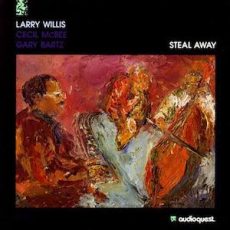
Requisites
Steal Away ~ Larry Willis | By Eddie Carter
This morning’s album from the library is Steal Away (AudioQuest Music AQ-LP 1009), a little-known release by pianist Larry Willis. It’s the first of two records Willis made for the label and his seventh as a leader. He’s joined on this date by Gary Bartz (tracks: A2, B1) on alto sax and Cecil McBee (A2, B1, B2) on bass. My copy is the 1992 U.S. Stereo audiophile album.
Side One opens with Valdosta Blues by Larry Willis, the first of three solo piano performances. The title comes from the city in Georgia and begins with the pianist’s tranquil introduction that builds to a breezy melody. His ensuing solo is a superb performance that moves easily toward an exquisite ending.
The title tune, Steal Away, is an American Negro spiritual by Wallace Willis. It has been with Larry since age three and was a favorite song of his Mother’s to sing. Willis opens with a delicately gentle introduction to Bartz and McBee’s very pretty melody. Gary’s opening solo is imaginative and confident. Larry follows with sweet notes that shine like the rays of the sun, and Cecil breezes blissfully through the closing statement into a gentle climax. Fallen Hero is Larry’s tribute to his brother Victor. He tells an intimate story that reveals his love and affection for his brother with reflective inspiration and tenderness.
“D” Bass-ic Blues by Cecil McBee starts with the bassist’s bowed introduction, setting up Bartz and Willis to join him in a medium-tempo theme. Larry eases into the first solo with joyful vitality. Gary keeps the ball rolling with a remarkable reading of melodic lines. Cecil lets his bass do the talking in the finale preceding the theme’s reprise and conclusion. Ethiopia is a hauntingly beautiful song by Larry Willis that’s presented as a duet with Cecil McBee. The duo starts with a tender melody, and then Larry’s opening statement is as gentle as a light summer rain. Cecil comes in next with a graceful interpretation ahead of the duo’s delicately pretty ending.
The Meaning of The Blues by Bobby Troup and Leah Worth is given a tasteful treatment by Willis. He makes the song his own in a solo showcase that’s warm and nostalgic, thoughtful and heartfelt into a serene finale of haunting dreaminess. Joe Harley produced Steal Away, Pierre M. Sprey was the recording engineer, and Bernie Grundman mastered the album. It’s a pure analog recording with a stunning soundstage that was pressed on 180 grams of audiophile vinyl and is a perfect demonstration record for any quality audio system. Larry Willis recorded twenty-one albums as a leader and many more as a sideman. If you’re a fan of piano jazz, I invite you to consider Steal Away by Larry Willis on your next record-shopping trip. It’s an excellent place to start your discovery of his music and a welcome addition to any jazz fan’s library!
~ Fallen Hero, Ethiopia, “D” Bass-ic Blues – Source: Album Liner Notes by Bill Kohihasse
~ American Negro Spirituals were songs that contained hidden codes and messages for enslaved people to escape on their own or through the Underground Railroad – Source: Wikipedia.org
© 2023 by Edward Thomas Carter
More Posts: choice,classic,collectible,collector,history,instrumental,jazz,music,piano
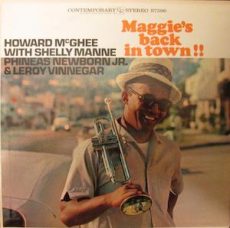
Requisites
Maggie’s Back In Town ~ Howard McGhee | By Eddie Carter
Howard McGhee opens this morning’s discussion with a superb 1961 album, Maggie’s Back In Town (Contemporary Records M3596/S7596). He was one of the earliest jazz musicians to begin playing bebop and became a leading trumpet player during the Forties. Howard was also an excellent arranger and composer who performed with some of the elite musicians during that era. Drug problems derailed his career during the fifties, but he returned in 1960 and recorded two impressive albums for Lester Koenig’s label. A first-class trio joins him on this studio session: Phineas Newborn Jr. on piano, Leroy Vinnegar on bass, and Shelly Manne on drums. My copy is the 1975 US Stereo reissue.
Side One opens with a Howard McGhee original, Demon Chase. The quartet swings easily into the melody; then, Howard gets to the song’s core first. Phineas follows happily along in the second reading. McGhee returns on muted horn with a solo that’s sheer heaven. Leroy closes things out ahead of the finale. Willow Weep For Me by Ann Ronell is one of the most beautiful and recorded song’s from The Great American Songbook. Newborn makes the introduction segueing into McGhee’s muted slow-tempo theme and mellow opening statement. Phineas demonstrates tenderness and intimacy next, and then Howard takes the song out thoughtfully with the mute removed.
Softly, As In a Morning Sunrise by Sigmund Romberg and Oscar Hammerstein II is taken at a brisk clip, with the leader’s mute building the melody effectively. Howard delivers the song’s only solo with joyful vitality fueled by the trio’s exceptional support ahead of the closing chorus and climax. Sunset Eyes by Teddy Edwards ends the first side. The rhythm section sets the scene for McGhee’s easygoing melody. The tempo moves upward for a fascinating interpretation by the leader. Newborn also puts together a well-constructed offering preceding the closing chorus and gentle fadeout.
Side Two starts with Maggie’s Back In Town, by Teddy Edwards. The title refers to Howard’s nickname and his return to the jazz scene after battling drug addiction. The quartet’s bluesy theme gets things underway, followed by Howard’s warm welcome in the first solo. Newborn’s second statement is as delicious as a good meal. McGhee returns for a short reading, and then Vinnegar takes a relaxing walk. Manne shares the closing statement with Howard ahead of the ending theme. Summertime by George and Ira Gershwin and DuBose Heyward starts at mid-tempo, with the leader back on a muted trumpet. McGhee’s solo is as enjoyable as a day at the seaside until the close.
Brownie Speaks by Clifford Brown takes off with the foursome’s vigorous uptempo workout. Howard generates plenty of heat in the first solo. Phineas takes a scintillating statement next. Leroy follows with a short, robust comment, and the leader’s finale flows vibrantly toward the climax. Lester Koenig produced Maggie’s Back In Town, and Roy DuNann was the recording engineer. It’s a great-sounding reissue with an outstanding soundstage that brings the quartet to your listening room with stunning fidelity. If you’re in the mood for a hard-bop album with great tunes and tight musicianship, I invite you to check out Maggie’s Back In Town by Howard McGhee on your next record shopping trip. It’s an excellent introduction to his music and a terrific album that’s sure to give you many hours of listening pleasure!
~ Together Again! (Contemporary Records M3588/S7588) – Source: Discogs.com ~ Softly, As In A Morning Sunrise, Summertime, Willow Weep For Me – Source: JazzStandards.com © 2023 by Edward Thomas Carter
More Posts: choice,classic,collectible,collector,history,instrumental,jazz,music,trumpet
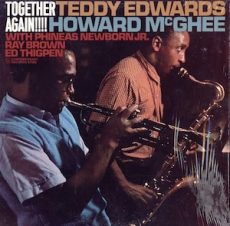
Requisites
Together Again!!!! ~ Teddy Edwards and Howard McGhee | By Eddie Carter
Teddy Edwards and Howard McGhee enter this morning’s spotlight with their excellent 1961 collaboration, Together Again!!!! (Contemporary Records M3588/S7588). The tenor saxophonist and trumpeter initially worked together from 1945 to 1947 when Edwards was a member of McGhee’s sextet. It’s their second collaboration since the Bebop era, but the first time the duo recorded together. The supporting cast is a magical rhythm section: Phineas Newborn Jr. on piano, Ray Brown on bass, and Ed Thigpen on drums. My copy is the 1975 U.S. Stereo reissue, sharing the original catalog number.
The album opener is the title track, Together Again, by Teddy Edwards. The quintet begins the melody harmonizing in perfect agreement. Howard takes the wheel and cruises leisurely on the opening statement. Teddy wails with a vibrant voice in the following solo. Phineas heightens the excitement with an impressive reading; then Ray adds a brisk footnote leading to the theme’s return and summation. McGhee introduces You Stepped Out Of A Dream by Nacio Herb Brown and Gus Kahn on the muted trumpet. He showcases the horn’s warm, lyrical tone in a lighthearted setting during two solos. In between them, Edwards gives a charming reading that bounces along over the rhythm section.
Up There by Ray Brown opens briskly from the pianist’s introduction, which evolves into the ensemble’s aggressive theme. Teddy tackles the first solo with fleet agility, and then Howard flies swiftly in the second statement. Phineas swings with a vengeance until the group’s theme restatement and abrupt finish. Side Two begins with Perhaps by Charlie Parker, featuring McGhee on muted trumpet during the opening and closing chorus. Edwards builds the opening solo exquisitely. Newborn follows with an exceptional interpretation. McGhee opens the horn for a passionately nimble reading, and Ray delivers the exclamation point into the group’s exit.
Teddy and the trio have the honors next on Misty by Erroll Garner and Johnny Burke. The quartet starts with a bass and piano duet. Teddy and Ed join them for the song’s very pretty melody. Edwards is the song’s only soloist and delivers an intimately personal interpretation that, to these ears, is one of the album’s highlights. Sandy by Howard McGhee begins with the quintet’s energetic theme. Howard is off to a rousing start on the lead solo. Edwards follows him with a reading of confident assurance. Newborn goes for the jugular next with vigorous enthusiasm. Brown wraps up the solos with dazzling bass lines preceding the quintet’s return to take the song out.
Lester Koenig produced Together Again!!!!, and Roy DuNann was the recording engineer. The reissue sounds great and possesses a vibrant soundstage, allowing the musicians to emerge from your speakers into your listening room with superb fidelity! Throughout the album, the quintet demonstrates how good West Coast jazz could sound in the right hands. The music is great from start to finish, and the musicians complement each other skillfully. If you’re a fan of Cool Jazz or Post Bop, I invite you to consider Together Again!!!! by Teddy Edwards and Howard McGhee on your next record-shopping trip. It offers the opportunity to appreciate two jazz giants who, after an absence of sixteen years, prove that great music doesn’t have an expiration date and can provide listening pleasure endlessly!
~ You Stepped Out of a Dream, Misty – Source: JazzStandards.com
~ Perhaps – Source: Wikipedia.org
© 2023 by Edward Thomas Carter
More Posts: choice,classic,collectible,collector,history,instrumental,jazz,music,saxophone,trumpet
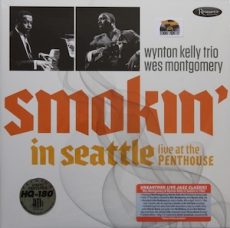
Requisites
Smokin’ In Seattle: Live at The Penthouse ~ Wynton Kelly Trio and Wes Montgomery | By Eddie Carter
I’ve been a fan of The Wynton Kelly Trio and Wes Montgomery since I was eleven and first heard Full House and Smokin’ at The Half Note. So, I was extremely happy to pick up a copy of Smokin’ In Seattle-Live at The Penthouse (Resonance Records HLP-9029), their 1966 live date over two nights from the Seattle, Washington jazz club. Jim Wilke of radio station KING-FM hosted a weekly half-hour program from The Penthouse, and he’s our Master of Ceremonies for the two sessions. The personnel for both dates are Wynton Kelly on piano, Wes Montgomery (tracks: A3 to A5, B3 to B5) on guitar, Ron McClure on bass, and Jimmy Cobb on drums. My copy is the 2017 US Mono audiophile release.
Jim Wilke kicks off Side One by welcoming the crowd and introducing the trio who opens with There Is No Greater Love by Isham Jones and Marty Symes. The group swings effortlessly through the melody, setting up Wynton’s spirited first solo. Ron comes in next for a lively presentation. Wynton and Jimmy share a brisk conversation in the closing statement leading to the song’s climax. Not a Tear by Rudy Stevenson begins deceptively like a ballad before the beat moves upward to an aggressive theme. Kelly has the song’s only solo and stretches out in a marvelous interpretation preceding the theme’s restatement.
Wes Montgomery joins the group on his original tune, Jingles. The quartet takes off on an upbeat theme. Wes goes right to work on an enthusiastic interpretation that bounces along into the foursome’s energetic finale. Up next is the poignantly beautiful standard by Bob Haggart and Johnny Burke, What’s New? The group also gives a pretty rendition of this tune on Smokin’ at The Half Note. Kelly begins with a politely touching introduction, segueing into the song’s gorgeous melody. Montgomery delivers a very personal performance in the song’s only solo ahead of the foursome’s gentle ending.
The first side ends on an upbeat note with the guitarist’s Blues In F. The group lays an impressive blueprint on the opening chorus. Wes has the solo spotlight to himself and delivers an exciting flow of ideas that sadly fade out due to the program’s time constraints. Mr. Wilke starts Side Two with his introduction to The Wynton Kelly Trio, who play The Theme, briefly starting their first number, Sir John, by Blue Mitchell. After the trio states the melody, Kelly gets his teeth into a brilliant opening statement. McClure lets his bass do the talking in the following solo before the pianist makes a few final comments, leading to the theme’s reprise.
If You Could See Me Now by Tadd Dameron and Carl Sigman is also on Smokin’ at The Half Note. The trio works together beautifully from the start of Wynton’s lush introduction. As the song’s only soloist, Kelly reveals the warmth and tenderness anchored by Ron’s and Jimmy’s support. West Coast Blues is a Montgomery original from Movin’ Wes. It comes to life with the guitarist’s introduction, segueing into the foursome’s easygoing theme. The song’s only solo belongs to Wes, and he delivers the goods to an infectious beat that is sure to have the listener tapping their feet ahead of the close.
O Morro Não Tem Vez by Antonio Carlos Jobim and Vinícius De Moraes is a beautiful Brazilian song and a highlight of the album Goin’ Out of My Head. Jimmy gets things going with a percussion introduction that blossoms into a lovely melody. Wes gets to stretch out and delivers a gorgeous performance preceding the foursome’s return for the theme’s restatement and climax. The album and set concludes with Oleo by Sonny Rollins. The ensemble starts things off with a zesty melody, then steps aside for Wes to take charge of the song’s only statement that concludes with a slow dissolve into nothingness.
Zev Feldman and George Klabin produced Smokin’ In Seattle. Jim Wilke was the original recording engineer, and Bernie Grundman mastered the album. The record was pressed on 180 grams of audiophile vinyl, and the album’s sound quality is quite good for a sixties live recording. The listener is transported to the club audience as the musicians are performing. The record is also incredibly quiet until Jim Wilke speaks. If you’re a fan of The Wynton Kelly Trio and Wes Montgomery, I offer, for your consideration, Smokin’ In Seattle the next time you’re out record-shopping. The music is simply amazing, and this is an album you shouldn’t miss for a spot in your library!
~ Full House (Riverside RLP 434/RS 9434), Goin’ Out of My Head (Verve Records V-8642/V6-8642), Movin’ Wes (Verve Records V-8610/V6-8610), Smokin’ at The Half Note (Verve Records V-8633/V6-8633) – Source: Discogs.com ~ If You Could See Me Now, Oleo, There Is No Greater Love, What’s New? – Source: JazzStandards.com
© 2023 by Edward Thomas Carter
More Posts: choice,classic,collectible,collector,history,instrumental,jazz,music,piano
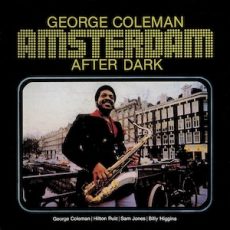
Requisites
Amsterdam After Dark ~ George Coleman | By Eddie Carter
George Coleman enters this morning’s spotlight with an excellent 1979 quartet album, Amsterdam After Dark (Timeless SJP 129). I first heard him playing alto on Houseparty and The Sermon. I later discovered he also played tenor and enjoyed his work on Eastern Rebellion, ‘Four’ and More, Maiden Voyage, Miles Davis In Europe, My Funny Valentine and Seven Steps To Heaven. This morning’s album from the library was his debut as a leader, and he composed four of the tunes. He’s joined on this date by The Hilton Ruiz Trio. Hilton Ruiz on piano and Eastern Rebellion colleagues Sam Jones on bass and Billy Higgins on drums. My copy is the original Netherlands Stereo release.
Side One opens with the trio’s introduction to the title tune, Amsterdam After Dark. George takes over and starts the fire burning on the song’s infectious melody and opening solo. Hilton sinks his teeth into the second reading, and then Sam speaks confidently, preceding the tenor’s joyful vitality in the closing chorus. Hilton Ruiz’s New Arrival picks up the quartet’s pace in an engaging opening chorus. Coleman takes flight first and builds a perfectly crafted interpretation effectively. Ruiz comes on next and is shown to great advantage in the closing statement ahead of the theme’s reprise and fadeout.
Lo-Joe is a feisty original that opens with an airy statement of the theme. George gets things going with a passionate first solo, followed by Hilton, who suggests a happy mood in the second statement. Billy’s brushwork in the closing statement swings very nicely into the foursome’s ending theme and exit. Autumn In New York by Vernon Duke is the album’s only standard. The quartet dresses up this old favorite with an intimately tender introduction and melody. Coleman’s opening statement is reflective and quite beautiful. Ruiz takes a moment for an elegantly exquisite comment leading to the leader’s delicately pretty ending.
Apache Dance is an impressive tune from the opening notes of the two-instrument conversation with tenor sax and drums, leading to a quick run of the ensemble’s theme. George unravels a lot of twists and turns in the first solo. Hilton comes right behind him, keeping his foot on the gas. Billy delivers the song’s final solo until the group reappears to take it out. Blondie’s Waltz begins with the quartet establishing an optimistic melody. Coleman starts things off with a beautifully phrased statement. Ruiz jumps in next to move things along in a lively interpretation. Higgins adds to the fun with a short spot until Coleman’s reappearance for the finale.
Wim Wigt produced Amsterdam After Dark. Bob De Caro and Jim McCurdy were the recording engineers. The album has an exceptional soundstage that comes through your speakers convincingly. If you close your eyes, it’s like the musicians are playing right in front of you. George Coleman is on fire throughout each selection, and the trio compliments him efficiently. At 88 years old, he’s showing no signs of slowing down and is still performing for jazz fans. I’ve caught a few of his performances at Smalls via their nightly streams. If you only have albums with George Coleman as a sideman, I invite you to take a trip to visit Amsterdam After Dark. It’s worth every penny for a spot in your library and is an excellent trip you can take without leaving the comfort of your chair!
~ Eastern Rebellion (Timeless SJP 101), ‘Four’ and More (Columbia CL 2453/CS 9253), Houseparty (Blue Note BLP 4002/BST 84002), Maiden Voyage (Blue Note BLP 4195/BST 84195), Miles Davis In Europe (Columbia CL 2183/CS 8983), My Funny Valentine (Columbia CL 2306/CS 9106), Seven Steps To Heaven (Columbia CL 2051/CS 8851), The Sermon (Blue Note BLP 4011/BST 84011) – Source: Discogs.com
~ Autumn In New York – Source: JazzStandards.com
© 2023 by Edward Thomas Carter
More Posts: choice,classic,collectible,collector,history,instrumental,jazz,music,saxophone


